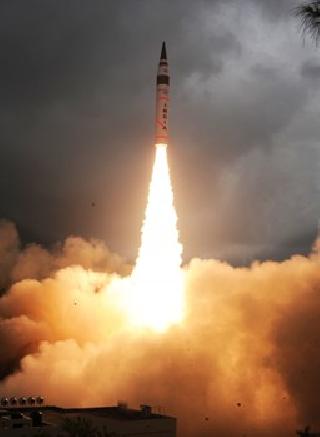
Agni V test firing on Sept 15. A DRDO photo
BALASORE, ODISHA (PTI): India on Sunday successfully conducted a second test flight of its indigenously developed nuclear-capable Agni-V long-range ballistic missile, which has a strike range of more than 5000 km, from the Wheeler Island off Odisha coast.
The three-stage, solid propellant missile was test-fired from a mobile launcher from the launch complex-4 of the Integrated Test Range (ITR) at about 8:50 AM, defence sources said.
Describing the trial as a success, spokesman of Defence Research & Development Organisation (DRDO) Ravi Kumar Gupta said it was successful like the maiden test flight of Agni-V missile conducted in April 2012.
The surface-to-surface missile, which can carry a nuclear warhead of more than one tonne, witnessed a flawless 'auto launch' and all data retrieved from different radars and network systems were thoroughly analysed to ascertain the overall outcome, the sources said.
"The sleek missile, within a few seconds of its blast-off from the Island launch pad, roared majestically into a clear sunny sky leaving behind a trail of thin orange and white column of smoke and within seconds it pierced into the sky," said an eye-witness to the launch.
Sunday's launch, conducted in the presence of defence scientists and experts, was the second developmental trial of the long range missile while the first test was conducted on 19 April, 2012 which was a total success.
The indigenously developed missile Agni-V is capable of striking a range of over 5000 km. It is about 17 meter long and 2 metres wide with launch weight of around 50 tonnes.
Unlike the other missiles of indigenously-built Agni series, the Agni-V is the most advanced version having some new technologies incorporated with it in terms of navigation and guidance, warhead and engine.
Many new technologies developed indigenously were successfully tested in the first Agni-V trial.
The redundant navigation systems, very high accuracy Ring Laser Gyro-based Inertial Navigation System (RINS) and the most modern and accurate Micro Navigation System (MINS) had ensured the missile reach the target point within few meters of accuracy.
The high speed onboard computer and fault tolerant software along with robust and reliable bus guided the missile flawlessly, said a defence official.
In the Agni series, India at present possesses the Agni-I with 700 km range, Agni-II with 2,000 km range, Agni-III and Agni-IV with 2,500 km to over 3,500 range.
After some more trials, Agni-V will be inducted into the services, the sources said.
 Previous Article
Previous Article Next Article
Next Article












The Indian Air Force, in its flight trials evaluation report submitted before the Defence Ministry l..
view articleAn insight into the Medium Multi-Role Combat Aircraft competition...
view articleSky enthusiasts can now spot the International Space Station (ISS) commanded by Indian-American astr..
view article